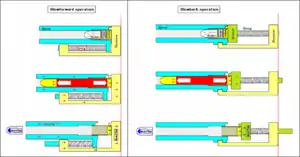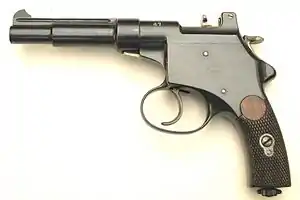Blow forward
Blow-forward is a firearm action where the propellant gas pressure and the friction of the bullet traveling down the bore drag the whole gun barrel forward to facilitate the opening of the breech.[1] This forward barrel motion provides most of the energy required to eject a spent cartridge case and chamber a fresh round of ammunition, and contains a minimum of moving parts and thus more compact than other operating mechanism of equal barrel length.


Description
Vast majority of repeating firearms have barrel fixed to the receiver or largely immobile in relation to the frame, with the breech face (as part of a moving bolt or slide) moving within the frame against the barrel. In contrast, the frame of a blow-forward firearm incorporates a fixed breech face, and the barrel is mobile and slides away from the breech (frame) during the operation cycle.
Due to the reduced mass of rearward-traveling parts coupled with the increased mass of the forward moving parts (barrel in addition to bullet and propellant gasses), recoil energy is significantly greater than other operating mechanisms. The barrel and spring are generally the only moving parts. Most blow-forward guns rely partially on the inertia of the barrel as the rest of the firearm recoil away from it.[2][3]
Examples
The first blow-forward firearm was the Mannlicher M1894 pistol and protected under U.S. Patent 581,296. The principle has been used in a few other weapons, including:
- Schwarzlose Model 1908
- Hino Komuro M1908 Pistol
- Mk 20 Mod 0 40mm automatic grenade launcher.
For an extensive list, see List of blow-forward firearms
References
- Hammerfell, Richard (7 March 2015). Firearms Illustrated - Pistol Edition. Digital Services. p. 166. GGKEY:PKJGL3K97WH.
- Smith, B. (7 March 2015). History of the Handgun. Digital Services. p. 1896. GGKEY:5F3APLD7J8C.
- Cunningham, Grant (2012). Gun Digest Shooter's Guide to Handguns. Iola, Wisconsin: Gun Digest Books. p. 22. ISBN 978-1-4402-3276-3.
